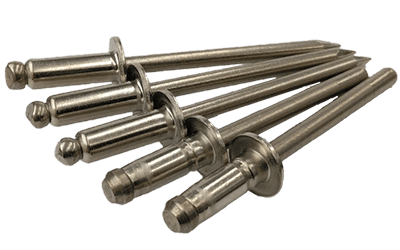What Is a Blind Rivet?

Riveting is one of the simplest and strongest ways to join metal plates that cannot be disassembled. A rivet, in the form of a pin with a head, is inserted into a through-hole machined in the joint area. The head side is supported by a base, and the pin side is plastically deformed by a hammer, press, etc., to secure the joint.
Currently, if the part to be joined has a sealed structure or is a large part that is difficult to handle, it may not be possible to insert the rivet from the backside of the joint or receive the head of the rivet by the base during riveting.
The blind rivet is a fastening component that enables joining from only one side of the part to be joined.
Uses of Blind Rivets
Since normal rivet joints have the same tightening strength as bolts and nuts and do not loosen after joining, they are used in a wide range of fields. These include hot-riveting ships, bridges, and steel towers to cold-riveting aircraft, general can manufacturing sheet metal products, and household pans and kettles.
Since blind rivets are an alternative to regular rivets, they are used in the same fields and products where rivets are used, but primarily as an alternative for cold joining with a rivet diameter of 2.4 to 6.4 mm.
Principle of Blind Rivets
A blind rivet consists of a body, similar in shape to a normal rivet but with a through-hole in the center of the rivet diameter, and a nail-shaped mandrel fitted into the through hole. The mandrel has a low head of smaller diameter than the rivet diameter at one end.
The mandrel is several times longer than the body and is inserted through the end of the body, with the end protruding toward the head of the body. The protruding mandrels of the blind rivets, which are a pair of mandrels and a body, are inserted into the head of the body with a special tool and passed through a pre-drilled hole in the sheet metal joint so that the head bearing surface of the body is in contact with the sheet metal.
In this state, the mandrel is pulled in with the special tool, and the low head of the mandrel tip compresses the end face of the rivet tip, causing it to be plastically deformed. A V-shaped groove is machined at the base of the mandrel’s low head, which is designed to break when the mandrel retracting force of the dedicated tool exceeds the rupture resistance of that part. The force equal to the rupture resistance causes plastic deformation of the body tip to join the target metal plates.
Specialized tools are available in manual, electric, and pneumatic types, depending on the drive system.